Winter charm
Camellias
Blooming throughout the cooler months, camellias tick many boxes with their robust evergreen foliage and vast choice of flower forms and colours. They make excellent hedges and are suitable for larger containers. Others can be trained as espaliers against a fence. Many are fragrant.
Plant camellias in well-drained, lime-free soil, enriched with compost. Because camellia roots grow close to the surface, mulching is highly recommended. Camellias will grow in sun or part shade. Those in full sun may need extra watering while young.
Magnolias
Winter is wakeup time for magnolias. Most will flower in late winter or early spring but already their furry buds are fattening. Few trees command more attention than a deciduous magnolia in bloom before its leaves emerge in spring. There is a magnolia sized to suit almost any size of garden. They thrive where well-drained soils meet a healthy rainfall. In hot, dry or windy locations pay extra attention to watering, mulching and shelter.
Plant magnolias in cool, moist, humus-rich soil. Their roots grow close to the surface and in a natural forest situation roots will grow out into the leaf mould on the forest floor to absorb nutrients.
Ericas
Neat little erica shrubs put on a brilliant show of all-over colour in late winter and spring, when they erupt into clouds of white, pink, red, and lilac. Choose a variety suitable for your region's winter conditions.
Plant ericas in lime-free, well-drained soil enriched with compost for optimal growth and flowering.
Daphne
A single sprig of daphne can fill a room with perfume. Such powerful fragrance on a small evergreen shrub is especially precious in mid winter. Pick the flowers regularly or trim lightly after flowering to keep growth compact, but do not prune right back below the foliage.
Plant daphne in cool lime-free soil, enriched with plenty of organic matter. Daphnes hate wet feet so good drainage is essential.
Success with Daphne
- Maintain a layer of organic mulch, but don’t pile it up around the stems.
- Choose part shade. All day direct sun can turn leaves yellow. However, too much shade will limit flowering.
- Avoid yellow leaves. The nutrient imbalance that leads to leaf yellowing is often caused by poor drainage or too high soil pH. Feed only with food for acid loving plants. If your soil is well-drained but yellow leaves persist, try a dose of iron chelates to correct a possible iron deficiency.
Loropetalum (fringe flower)
Loropetalums are enjoyed for their dense lustrous foliage and pretty flowers. Depending on variety the leaves vary in colour from deep green to burgundy or purple. Appearing in great abundance from winter or early spring, the flowers create a fringe-like effect with their ribbon-like petals in shades of white, cream, pink or purple. These tidy evergreens are great for trimming as a stand-alone feature or hedge.
Performing well in full sun to partial shade with well drained soil, they are drought-tolerant once established.
Understated beauty
Not every garden has room for a large deciduous shrub that is uninteresting for most of the year, but these old timers add a special something to the winter garden.
- Witch hazel (Hamamelis) with its fragrant spidery flowers on silvery zig-zagging twigs.
- Wintersweet (Chimonanthus praecox) with its spicy scent and small waxy flowers make superb vase displays.
- In late winter the reddish brown stems of Stachyurus praecox is adorned with elegant chains of chartreuse yellow bells while the leaves, which follow in quick succession, mature from copper to green over spring and summer them fiery autumn tones. This large spreading shrub makes an appealing small garden tree or can be trained as an espalier.
The Protea family
The South Western Cape of South Africa is home to some of the most dramatic garden plants known to man, most famously, the mighty proteas. Winter flowering proteas number among the world’s favourite cut flowers on plants that range in size from the imposing King Protea (Protea cynaroides) down to dainty shrubs. They ’re also wonderful plants for attracting native birds.
In the wild, proteas thrive on exposed mountains and clifftops subject to full sun, wild wind and very free draining slopes. Once established, they thrive in windy gardens with nutrient poor soils. They are salt tolerant too, so great for our coastal gardens.
Leucadendrons and Leucospermums are fantastic winter vase flowers. These colourful members of the protea family are easy to grow in well drained soil and offer a wide choice of varieties. All perform well in coastal gardens.
Grevilleas and Banksias are the Australians cousins of the South African proteas. Like proteas, they are magnets for nectar seeking birds and bees, and are extremely diverse in their growth habits, foliage and flower styles.
Grevillea colours range from bright reds, oranges, and yellows to hues of pinks, mauves and creams. There are grevillea trees, shrubs of all sizes and wide spreading ground cover gevilleas. Some make great hedges. Many will flower throughout the year, but grevilleas are enjoyed mainly in winter when their bright flowers stand out. Regular pruning maintains an attractive bushy shape and further flowering.
Banksias also flower mainly in winter and are a fabulous food source for nectar seeking birds. They also attract insects, a further food source for birds. Their strikingly architectural flowers are produced in huge profusion for many weeks. Banksias range from tall trees to low spreading shrubs. They adapt to a wide range of conditions and are well known for their drought tolerance.
Protea perfection
For proteas, leucadendons, grevilleas and other members of the protea family:
- Plant in full sun. Choose a spot with ample air flow to prevent disease.
- Ensure adequate drainage. A porous, raised or sloping soil is best. Proteas will grow well in clay-based soils, as long as the water can drain away.
- Plant with care. Winter is a good time to plant, and a good time to find them in garden centres. In cold climates however, plant in spring once the risk of frost is over.
- Water and feed with a low-phosphate, slow-release fertiliser at planting time. This will help plants establish well, but generally, a soil low in nutrients suits their highly efficient, fine roots.
- Once established, most proteas will tolerate long dry periods. However with reasonable rainfall over free draining soil, they’ll thrive.
- Pick flowers often and trim after flowering to encourage healthy, bushy growth. Without pruning plants can grow leggy and tall.
Colourful natives
NZ flaxes (Phormium varieties) thrive on windy sites and offer lots of contrasting colours. For their best colour and healthy compact growth, plant flaxes in full sun. Lift and divide every few years to keep plants looking fresh.
The architectural shapes of clipped shrubs provide valuable structure and interest to a garden, especially in winter. New Zealand’s fine leafed Corokias are very hardy and easy to grow, and a top choice for trimming. They offer an exciting range of different leaf colours. Coprosmas present a huge variety of colours and textures, from tiny to large leaves, high gloss to matt. Coprosmas are wind and coastal tolerant. Some are frost tender.
Buds bark and berries
Trees with beautiful bark take their turn in the winter limelight. Paper birch, Tibetan cherry and the paper bark maple are among those trees planted especially for their bark. The crepe myrtles (Lagerstroemia) are stunning in summer bloom, but their bark is a feature in winter. Few deciduous shrubs look as good with their clothes off as Cornus alba ‘Sibirica ’ with its thicket of crimson stems.
A little crabapple tree loaded with bright baby apples is a lovely sight in mid winter. Malus ‘Gorgeous ’ and ‘Jack Humm’ make delicious jelly but they ’re worth growing for looks alone. Rose hips are another great source of winter colour. Holly is legendary for winter colour but for berries a female plant needs pollinating via a nearby male. Holly berries are poisonous.

15-Jun-2023
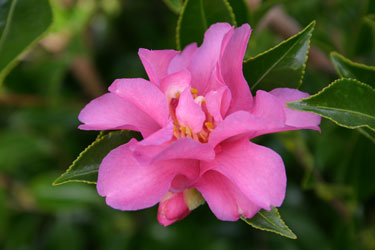
Camellia Bonsai Baby

Magnolia Vulcan
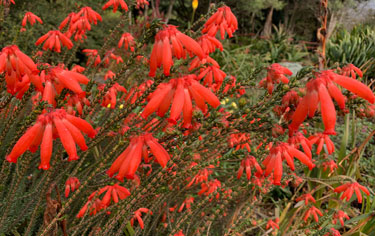
Erica cerinthoides (Scarlet heath)
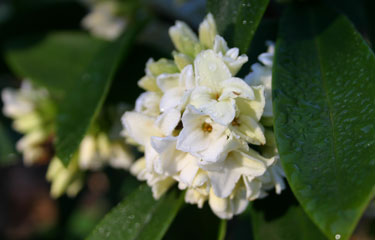
Daphne alba
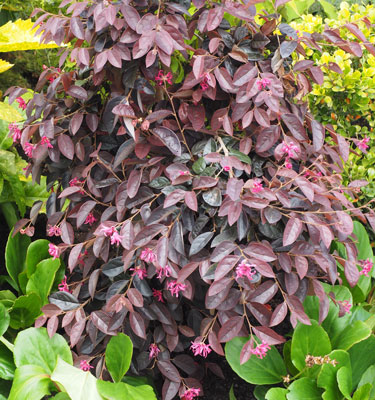
Loropetalum
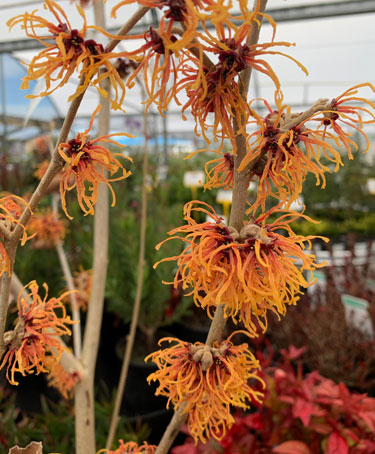
Witch hazel
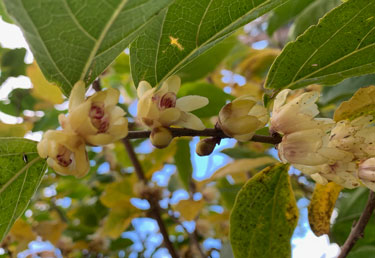
Wintersweet
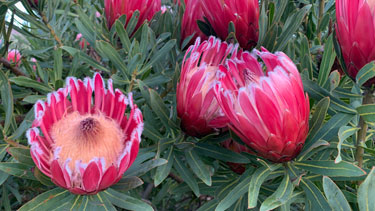
Protea Frosted Fire
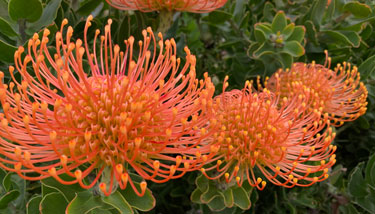
Leucospermum Harry Chittick
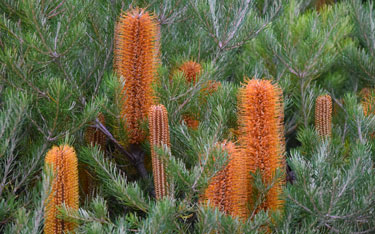
Banksia ericafolia (Heath Banksia)
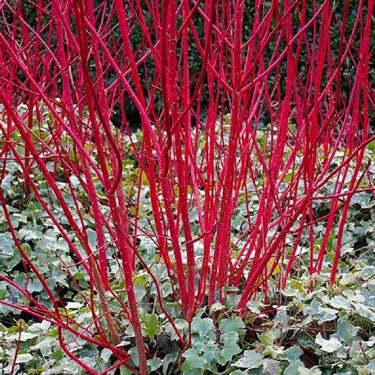
Cornus alba 'Sibirica'

